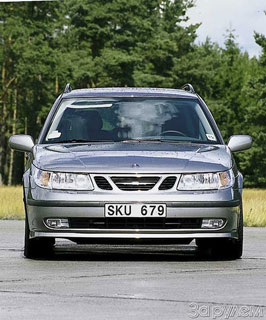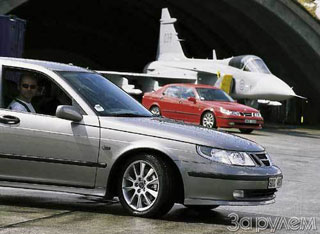Saab test drive 9-5 2001-2005 sedan
Autopilot, Bixenon and 2 turbo-diesel
 Saab 9-5 made his debut in the summer of 1997; In 1998, a station wagon appeared, and in 1999-the most powerful version of Aero. In the updated version, it is equipped with gasoline engines with a boost of 2.0-3.0 liters, from 110 to 184 kW and diesels of 2.3 and 3.0 liters, 92 and 130 kW. Aggregated with five -speed mechanical or automatic transmission boxes.
Saab 9-5 made his debut in the summer of 1997; In 1998, a station wagon appeared, and in 1999-the most powerful version of Aero. In the updated version, it is equipped with gasoline engines with a boost of 2.0-3.0 liters, from 110 to 184 kW and diesels of 2.3 and 3.0 liters, 92 and 130 kW. Aggregated with five -speed mechanical or automatic transmission boxes. Find ten differences
We put an updated car and its predecessor nearby: fashionable transparent headlights - one, a radiator grille integrated in the front bumper - two ... what else? Okay, relax. Despite small external differences, in the updated SAAB 9-5, 1265 changes found a place - there is clearly not enough fingers.
They touched the chassis, steering, lighting equipment, interior. The range of power units has expanded, a multifunctional electronic stabilization system has appeared. Now more about the most interesting.
 Behind the solid and unperturbed lines of the body, an even more tenacious suspension is now hiding. The rigidity of the front springs is increased by 10%, the diameter of the reptile stability stabilizer is 1 mm. Obviously, the characteristics of the shock absorbers have changed. All this is intended to reduce the already small rolls, making the car even more obedient. They enhanced the upper supports of shock absorber racks - for better perception of lateral loads. To improve the feeling of the road, the steering rack was lowered (this increased the stiffness of the steering), it became tougher and the torsion rod in the amplifier (this is responsible for jet force on the steering wheel). The front subframe is tougher and at the same time easier. They did not go around the rear suspension, where there are plenty of improvements.
Behind the solid and unperturbed lines of the body, an even more tenacious suspension is now hiding. The rigidity of the front springs is increased by 10%, the diameter of the reptile stability stabilizer is 1 mm. Obviously, the characteristics of the shock absorbers have changed. All this is intended to reduce the already small rolls, making the car even more obedient. They enhanced the upper supports of shock absorber racks - for better perception of lateral loads. To improve the feeling of the road, the steering rack was lowered (this increased the stiffness of the steering), it became tougher and the torsion rod in the amplifier (this is responsible for jet force on the steering wheel). The front subframe is tougher and at the same time easier. They did not go around the rear suspension, where there are plenty of improvements. In general, the car began to respond faster to the actions of the driver and hold on to the road more tenaciously. True, in the skid, the car breaks the car in the blink of an eye. However, now this can not be afraid - an autopilot has appeared on Saab!
 I am nine five, please take off
I am nine five, please take off What do you think, what did you decide to put the emphasis on, showing reporters an updated car? Of course, at the work of the ESP system. And there was a rite of initiation into pilots not somewhere, but at a specially rented airfield. A dozen 250-horsepower airfolds in a low-profile Michelen 225/45R17 looked impatiently at the runway of the military airfield leaving into the distance. Test pilotes, meanwhile, explained the task.
There are two main exercises: a detour of obstacles at a speed of 65-70 km/h (moose test) and a sharp change in the strip (rearrangement) by 110-120 km/h. To complete the picture, the exercise is proposed to be performed alternately - with the ESP turned off and turned on (disconnected by the button on the panel with a fixed car).
And what kind of Russian does not like fast driving! - It is quite fair for the international journalistic fraternity. It is unlikely that among three dozen test drivers there were indifferent, who did not try to challenge the smart Saabov autopilot. What is the result? When performing a short elk dough, it seemed that an experienced driver was not inferior to electronics. But at high speeds ... cars on low -profile road tires, imprisoned under a quick ride, tenden to break very sharply in the ski on dry asphalt. Saab is no exception. And when the car is provoked ... In general, at high speed, electronics outplayed us. In our defense, we say that a person in this duel finds himself in obviously unprofitable conditions. He is not supposed to slow down, while the ESP system actively uses the favorite receiver - inhibiting one of the wheels. Of course, one more points could be fined an electronic assistant - for changing the trajectory. But this cannot be compared with the behavior of a car lost by a person. So, gentlemen, they survived.
 For the first time in a diesel class
For the first time in a diesel class Nevertheless, the 2002 SAAB will be remembered not updated and not electronic stabilization. The news of the appearance of nine five turbodiesels was truly revolutionary for the auto guns. And what - a three -liter V -shaped six with a boost - a rarity on cars. An aluminum block with a collapse angle of 66, four valves per cylinder, a Garrett turbocharger with an adjustable input guide of a turbine, a battery power system (Common Rail). Designed together with Isuza, a partner in the JI-EM concern, diesel at 1800 rpm develops the moment 350 N.M. The engineers even complained that they were forced to slightly reduce this indicator so as not to worsen the comfort of driving. With such a weakened diesel engine, SAAB 9-5 accelerates to hundreds in 9.3 seconds. Comments, as they say, are unnecessary.
Yes, I almost forgot: the car is about to appear with another diesel, a slightly smaller volume. This is a modernized 2.2 TID motor, known for the 9-3 model. Only nine five diesel will give 92 kW of maximum power and 280 N.M of torque. It's not bad too.
Not just fashion
The company would have changed itself, without taking another seven -mile step towards raising safety. This time shown bixenon headlights.
What does the BI prefix mean? At least she speaks of two xenon lamps in each headlight. One of them works only in high light mode, the other - both in the far and in the neighbor. Moreover, in the latter case, the only lamp is involved, and the necessary lighting is provided by a special metal plate. If it is raised, the near light, lowered - is far.
Thanks to the new headlights, the illumination of the road in both modes has improved. Self -confident Swedes call the figure worthy of respect - 60%! Truly a radical measure of safety increase.
Text, photo / Alexander Budkin

Source: The magazine "Driving"
Video crash tests Saab 9-5 2001-2005
Saab test drives 9-5 2001-2005
Saab Crash Test 9-5 2001-2005
Krassh Test: Detailed Information33%
Driver and passengers
12%
Pedestrians












